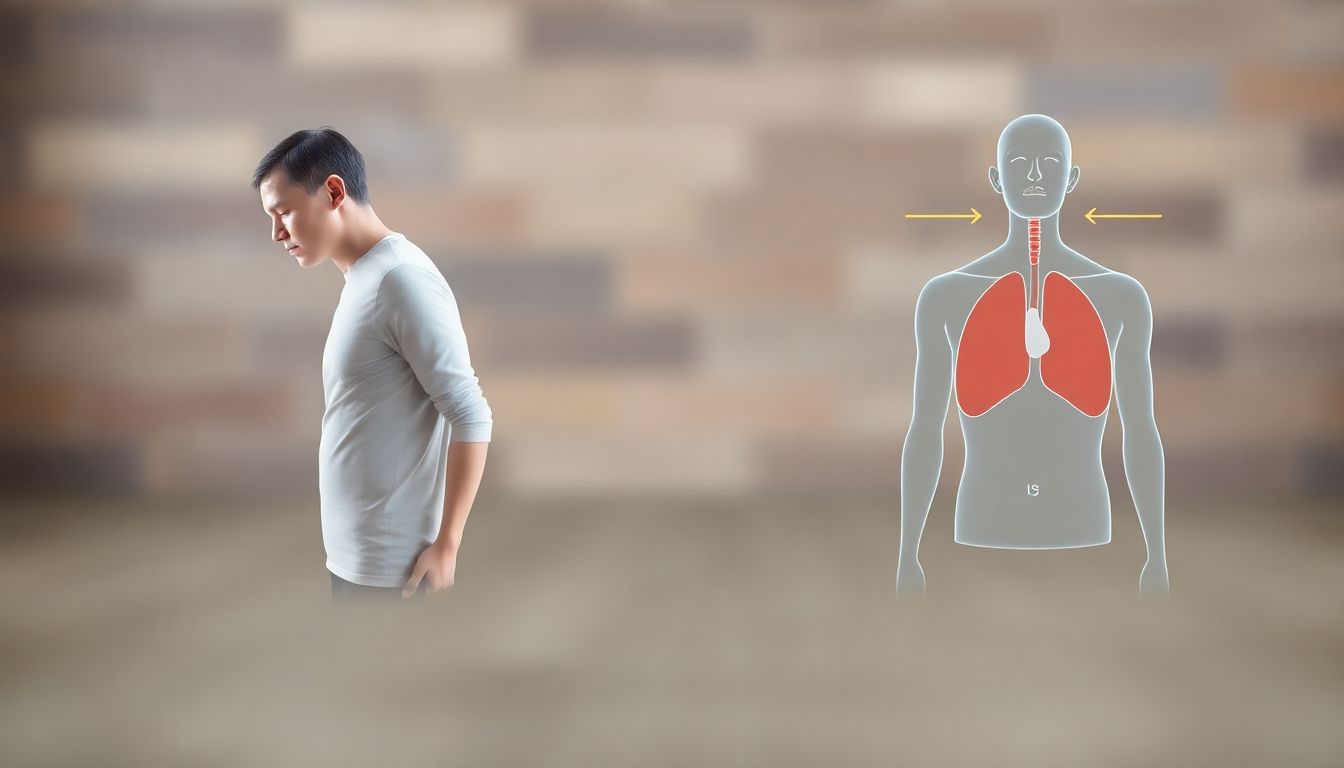If you’ve ever noticed you can breathe deeper when standing tall compared to when you’re slumped over your desk, you’ve experienced one of the most overlooked aspects of respiratory health: your posture directly dictates your breathing capacity.
The relationship between your spinal alignment and your breathing isn’t just theoretical—it’s mechanical. When your posture compresses your chest cavity and restricts diaphragmatic movement, you’re literally fighting against your own body to take a full breath. The good news? Simple postural corrections can instantly unlock significant breathing space you didn’t know you had.
The Anatomy of Breathing: Your Diaphragm’s Real Estate
To understand why posture matters, you need to understand your breathing anatomy:
Your Diaphragm’s Living Space:
- This dome-shaped muscle needs room to flatten and descend during inhalation
- Poor posture reduces this available space by up to 30%
- Imagine trying to expand a balloon in a small box versus an open room
Your Rib Cage’s Mobility:
- Your ribs should expand like bucket handles during inhalation
- Slumped posture locks ribs in a downward position
- This reduces lung expansion regardless of lung health
Accessory Muscle Overload:
- When diaphragm space is limited, neck and chest muscles overwork
- This creates tension, fatigue, and inefficient breathing patterns
This mechanical understanding explains why many breathing issues respond better to postural correction than to respiratory treatments alone. As we explore in Diaphragmatic Breathing: The #1 Exercise to Strengthen Your Lungs, proper mechanics are foundational.
5 Common Postural Patterns That Steal Your Breath
1. The Forward Head Position (“Text Neck”)
- How it hurts breathing: Compresses trachea, restricts neck muscles, alters rib alignment
- Common in: Desk workers, smartphone users
- Breathing impact: Up to 30% reduced lung capacity
2. The Rounded Shoulders Posture
- How it hurts breathing: Closes the front chest wall, limits rib expansion
- Common in: Cyclists, computer users, people with weak back muscles
- Breathing impact: Restricted upper lung expansion
3. The Slumped Sitting Position
- How it hurts breathing: Compresses abdominal space, limits diaphragmatic descent
- Common in: Office workers, drivers, anyone sitting prolonged periods
- Breathing impact: Shallow chest breathing pattern
4. The Anterior Pelvic Tilt
- How it hurts breathing: Tight hip flexors pull pelvis forward, compressing lower abdomen
- Common in: People with sedentary lifestyles, certain exercise patterns
- Breathing impact: Reduced lower lung expansion
5. The Swayback Posture
- How it hurts breathing: Rib cage drops forward, reducing thoracic space
- Common in: Pregnancy, high heels wearers, certain body types
- Breathing impact: Compromised breathing mechanics
The 5-Minute Daily Posture Reset for Better Breathing
This simple routine can dramatically improve your breathing mechanics in just minutes per day:
1. Chin Tuck and Reach (1 minute)
- Sit or stand tall, gently tuck chin without nodding head
- Reach crown of head toward ceiling, feeling spine lengthen
- Why it works: Counters forward head posture, creates space for breathing
2. Doorway Chest Opener (1 minute)
- Place forearms on doorframe with elbows at shoulder height
- Step through doorway until gentle stretch felt in chest
- Why it works: Releases tight chest muscles that restrict breathing
3. Seated Thoracic Rotation (1 minute)
- Sit tall, cross arms over chest, rotate gently side to side
- Keep hips facing forward, rotate from mid-back
- Why it works: Improves rib cage mobility for better expansion
4. Diaphragmatic Breathing Practice (2 minutes)
- Lie on back with knees bent, practice Diaphragmatic Breathing
- Focus on expanding abdomen and lower ribs
- Why it works: Retrains breathing pattern in optimal position
Optimal Positions for Maximum Breathing Efficiency
Sitting Posture for Deep Breathing:
- Hips higher than knees (use cushion if needed)
- Shoulders relaxed back and down
- Ears aligned over shoulders
- Computer screen at eye level
Sleeping Positions for Unrestricted Breathing:
- Side sleeping: Pillow between knees, head pillow supporting neck alignment
- Back sleeping: Elevated head position, pillow under knees
- Avoid: Stomach sleeping (twists neck, compromises breathing)
Standing Posture for Full Expansion:
- Weight evenly distributed on both feet
- Knees slightly bent, not locked
- Rib cage lifted, not slumped forward
- Chin parallel to ground
These positions complement the techniques in Best Yoga Poses for Lung Capacity and Chest Opening by creating the structural foundation for optimal breathing.
When Poor Posture Masks as Breathing Conditions
Many people receive respiratory diagnoses when the real issue is mechanical:
“Postural Asthma”:
- Symptoms: Wheezing or tightness that improves with position changes
- Reality: Rib restriction and muscle tension mimicking asthma
- Solution: Postural correction and breathing retraining
“Desk Breathlessness”:
- Symptoms: Shortness of breath that worsens during work hours
- Reality: Prolonged sitting compromising breathing mechanics
- Solution: Frequent postural resets and workstation adjustment
“Evening Wheezing”:
- Symptoms: Breathing difficulties that develop as day progresses
- Reality: Cumulative postural fatigue and muscle tension
- Solution: Daily postural maintenance routine
If you’re experiencing breathing patterns that don’t fit typical diagnoses, our guide Is It Asthma or Something Else? 5 Conditions Often Misdiagnosed might provide additional insights.
Tools and Supports for Breathing-Friendly Posture
Ergonomic Upgrades:
- Standing desk: Alternates sitting and standing
- Lumbar support: Maintains spinal curves during sitting
- Monitor riser: Keeps screen at eye level
- Supportive chair: Promotes pelvic neutrality
Movement Breaks:
- Set timer for every 30 minutes of sitting
- Stand, stretch, take 5 deep breaths
- Reset posture before continuing work
Sleep Environment:
- Supportive mattress: Maintains spinal alignment
- Proper pillows: Keep neck in neutral position
- Positional aids: Body pillows for side sleeping
The Mind-Posture-Breathing Connection
Your mental state affects your posture, which in turn affects your breathing:
Stress Response:
- Anxiety causes shoulder raising and chest tightening
- This creates restricted breathing patterns
- Breaking this cycle requires addressing all three elements
Conscious Awareness:
- Regular posture checks throughout day
- Breathing awareness as posture feedback
- Using breath as cue to reset alignment
This connects to the principles in The Vagus Nerve & Your Lungs: The Missing Link to Calming Coughs, where posture influences nervous system regulation.
The Bottom Line: Your Posture is Your Breathing Foundation
Optimizing your posture might be the most overlooked strategy for improving breathing function. Unlike many respiratory interventions that take weeks or months to show effects, postural corrections can provide immediate breathing improvements.
Remember that posture isn’t about rigidly holding a position—it’s about creating dynamic alignment that supports your body’s natural breathing mechanics. Small, consistent adjustments throughout your day create compounding benefits for your respiratory health.
Your breathing capacity is literally shaped by how you hold your body. By giving your diaphragm and lungs the space they need to function optimally, you’re not just breathing better—you’re creating a foundation for overall health and vitality.
10 FAQs for the Article:
1. How much can posture actually affect my breathing capacity?
Poor posture can reduce lung capacity by up to 30%. When you slouch, you compress your rib cage and abdominal space, physically limiting how much your lungs can expand and your diaphragm can descend.
2. What’s the connection between my spine and breathing?
Your spine’s alignment determines your rib cage position. When vertebrae are properly aligned, ribs can expand fully during inhalation. Spinal misalignments physically restrict rib movement, reducing lung expansion regardless of lung health.
3. Can correcting my posture really help chronic breathing issues?
Absolutely. Many people with diagnosed respiratory conditions find significant improvement simply by addressing postural habits. Proper alignment creates mechanical advantage for breathing muscles and maximizes existing lung function.
4. What is “text neck” and how does it affect breathing?
Text neck refers to the forward head position from looking down at devices. This posture compresses the trachea, restricts neck muscles needed for breathing, and alters rib cage position, reducing lung capacity by up to 30%.
5. How does sitting all day impact my breathing?
Prolonged sitting causes hip flexors to tighten, which pulls the pelvis forward and compresses abdominal space. This limits diaphragmatic movement and forces shallow, inefficient chest breathing.
6. What’s the best sleeping position for optimal breathing?
Side sleeping with proper pillow support maintains spinal alignment and keeps airways open. Back sleeping can be good if head is elevated, while stomach sleeping typically compromises breathing mechanics.
7. Can poor posture cause shortness of breath even with healthy lungs?
Yes, this is common. Mechanical restrictions from poor alignment can create sensations of breathlessness even with perfectly healthy lung tissue by limiting the physical space available for breathing movements.
8. How quickly can I see improvements in breathing from posture correction?
Many people notice immediate improvements in breathing depth with proper alignment. Significant lasting changes typically develop over 2-4 weeks of consistent postural awareness and corrective exercises.
9. What’s the relationship between posture and asthma symptoms?
Poor posture can worsen asthma by keeping chest muscles chronically tight and reducing mechanical breathing efficiency. Many asthmatics find symptom improvement with postural correction alone.
10. Are there specific exercises to improve breathing posture?
Yes, focus on exercises that open the chest, strengthen upper back muscles, release tight chest and hip flexors, and promote spinal extension. These create the physical foundation for optimal breathing mechanics.











